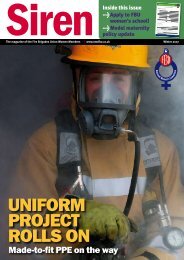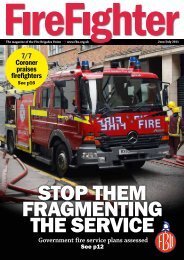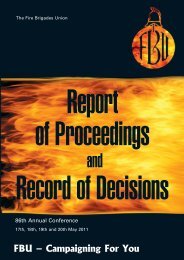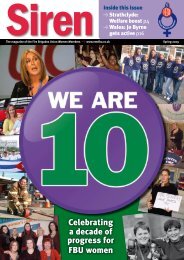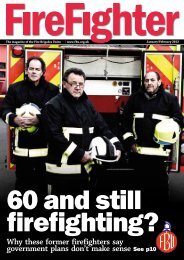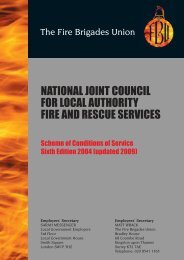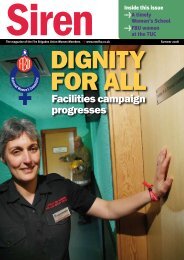Draft London Safety Plan 2010/2013 - Fire Brigades Union London
Draft London Safety Plan 2010/2013 - Fire Brigades Union London
Draft London Safety Plan 2010/2013 - Fire Brigades Union London
Create successful ePaper yourself
Turn your PDF publications into a flip-book with our unique Google optimized e-Paper software.
Around 20 percent of our calls to false alarms from<br />
automatic fire systems are to places where we will attend<br />
more than 20 times in the same year.<br />
Map 7 – targeting map for preventing false alarms<br />
from automatic fire alarm systems<br />
We would like every place where people live, work or<br />
socialise to have a working fire detection system to give<br />
early warning in the event of a fire. But for these systems<br />
to be effective, they must also be properly maintained so<br />
they don’t activate falsely.<br />
To achieve a reduction in false alarms from automatic fire<br />
alarm systems we have set long-term targets to reduce<br />
these incidents where they occur in non-domestic<br />
buildings. Most commercial buildings and other buildings<br />
accessible to the public need to comply with fire safety<br />
regulations which include procedures for raising the<br />
alarm in the event of a fire. We believe that faulty systems<br />
and those that regularly and frequently activate falsely<br />
aren’t effective and so we will work primarily with the<br />
responsible people for these types of premises to reduce<br />
false calls .<br />
In July 2009 we introduced a call filtering process in our<br />
‘999’ control centre so that we don’t need to attend these<br />
false alarms when the occupiers can confirm that the<br />
system operated unnecessarily. We hope this action,<br />
together with our unwanted fire signals strategy, will help<br />
to dramatically reduce the number of calls we attend.<br />
PEOPLE SHUT IN LIFTS<br />
In 1966 the LFB attended just 935 incidents to people<br />
shut in lifts (less than three a day). Nearly 40 years later<br />
we are attending around 16,000 calls a year (more than<br />
45 calls a day). When we started to attend these calls we<br />
did so in good faith that we were providing a public<br />
service. However the LFB have no statutory<br />
responsibilities to attend these incidents (except in cases<br />
of genuine emergency) and what we are finding now is<br />
that lift owners are using our services instead of having<br />
the adequate maintenance and release arrangements<br />
required of them under health and safety regulations. We<br />
no longer feel that this is a good use of public money as<br />
we are, in effect, supporting other organisations by<br />
providing them with a service they are duty bound to<br />
provide themselves. It is a very poor use of the<br />
professional skills of our firefighters.<br />
In September 2009 we introduced a call filtering process<br />
for calls received to our 999 Brigade Control to shut in lift<br />
incidents. Where there is a genuine emergency (for<br />
example the person inside requires medical assistance)<br />
we will attend with an emergency response. Where it is<br />
clear that the lift owner has adequate rescue<br />
arrangements of their own, we will defer to their service.<br />
For the time being, if it isn’t clear that alternative<br />
arrangements exist, and there isn’t a genuine emergency,<br />
we will attend but will do so at a much safer road speed<br />
(than when on ‘blue lights’) and we shall make a charge<br />
to the owner for providing the service where we are<br />
called repeatedly to the same address.<br />
Map 8– targeting map for preventing shut in lift<br />
incidents<br />
We will continue to work with lift owners to advise them<br />
of their regulatory obligations and the adverse impact that<br />
us attending their lift has on the emergency and<br />
prevention services we provide.<br />
MALICIOUS FALSE ALARMS (HOAX CALLS)<br />
We receive around 16 malicious ‘hoax’ calls each day.<br />
Through our policy of not attending abandoned calls and<br />
‘call challenging’ suspected hoaxers we make an<br />
emergency attendance to less than half of all hoax calls<br />
we receive.<br />
19





